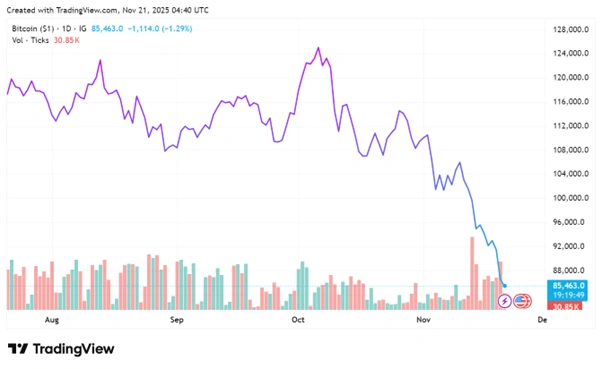Wall Street delivered one of its most dramatic intraday reversals of 2025 on Thursday, November 20, as a morning rally sparked by stellar Nvidia earnings crumbled into a tech-led sell-off. The stunning turnaround erased hundreds of billions in market value within hours.
Major indices completed breathtaking U-turns. The Dow Jones Industrial Average plunged 386 points after climbing more than 700 points earlier in the session. The S&P 500 fell 1.6% following a 1.9% morning surge. The tech-heavy Nasdaq Composite dropped 2.16% after trading up 2.6% at the open.
The scale of the reversal was historic. Peak to trough, the Nasdaq swung nearly 4.9% during the session, marking one of the sharpest intraday moves since April.
Nvidia Sparks Rally Before Leading Retreat
The session began with genuine optimism. Nvidia reported third-quarter revenue that jumped 62% year-on-year to approximately $57 billion, smashing Wall Street forecasts. The chipmaker guided fourth-quarter sales to roughly $65 billion and described AI accelerator demand as “off the charts.”
Nvidia shares initially surged as much as 5%, lifting the broader market. The company’s strong results eased concerns about an AI bubble and prompted buying across technology names.
But the enthusiasm proved short-lived.
By midday, Nvidia had reversed course entirely, closing down 3% despite the blockbuster earnings. The chipmaker’s gravitational pull on major indices meant its decline dragged the broader market into the red.

Jobs Report Derails Rate Cut Expectations
The catalyst for the reversal came from an unexpected source. A stronger-than-expected September jobs report diminished expectations that the Federal Reserve would cut interest rates in December.
Solid payroll numbers suggested diminished risks of higher unemployment, leading Morgan Stanley analysts to declare they “no longer expect a Fed cut in December.”
When investors don’t anticipate rate cuts, they often reduce exposure to growth stocks. Lower interest rates typically boost stock valuations by making borrowing cheaper and encouraging investment. The jobs data effectively removed that support.
Tech Sector Bears Brunt of Selling
Technology names absorbed the heaviest losses as the session progressed. Western Digital, the year’s best-performing stock, plummeted 9%. Micron dropped 9%, Palantir fell 4%, and Lam Research declined over 5%.
The Philadelphia Semiconductor Index tumbled 3.4%, leading the broader tech retreat.
AMD, Micron Technology, and Oracle experienced declines ranging from 6.6% to 10.9%. Even tech giants like Amazon and Palantir saw early gains evaporate completely.
The sell-off extended beyond US borders. Canada’s S&P/TSX Composite Index closed at 29,932, down 346 points or 1.14%, falling below the psychologically important 30,000 level after Celestica reversed more than 5% lower.
Bitcoin Joins the Carnage
Cryptocurrencies weren’t spared. Bitcoin fell below $87,000, marking its lowest level since late April. Ethereum and other major tokens also posted sharp declines. The crypto sell-off pressured related equities. Coinbase and Robinhood ranked among the worst S&P 500 performers, down 6% and 8% respectively.

Broader Market Implications
The tech sector’s dominance meant just a handful of companies accounted for the bulk of the decline. Nvidia and Broadcom alone represented significant portions of losses in major index funds.
This concentration risk has become increasingly apparent throughout 2025. The have faced similar concerns about market leadership.
The reversal marked one of the biggest intraday swings since April, underscoring how fragile sentiment around AI and interest rates has become.
Recent market volatility has raised questions about whether the AI-driven rally can sustain current valuations without corresponding revenue growth.
What’s Driving the Uncertainty?
Multiple factors contributed to Thursday’s dramatic reversal:
- Valuation concerns: Tech stocks reached elevated price-to-earnings ratios after months of gains
- AI profitability questions: Uncertainty about whether massive AI infrastructure spending will generate returns
- Rate expectations: Jobs data suggesting the Fed will keep rates higher for longer
- Profit-taking: After strong 2025 gains, investors locked in profits when momentum faltered
Market breadth deteriorated sharply, with more declining stocks than advancing ones across both the NYSE and Nasdaq.
Also Read: Coalition Willing to Rush Through Nature Laws as Environmental Watchdog Faces Axe
Investor Outlook
Some analysts view the pullback as a potential opportunity. The underlying story of strong AI demand and eventual Fed rate cuts hasn’t fundamentally changed in a single session.
However, the episode highlighted the precarious nature of a market dependent on a narrow group of technology leaders. The DeepSeek AI disruption earlier this year demonstrated similar vulnerability.
For Australian investors monitoring ASX market movements, Thursday’s volatility served as a reminder of global tech’s influence on local markets.
The magnitude of Thursday’s reversal suggests markets are entering a more turbulent phase where sentiment can flip dramatically on incremental data. Position sizing, diversification, and awareness of concentration risk will be crucial for navigating this environment.












